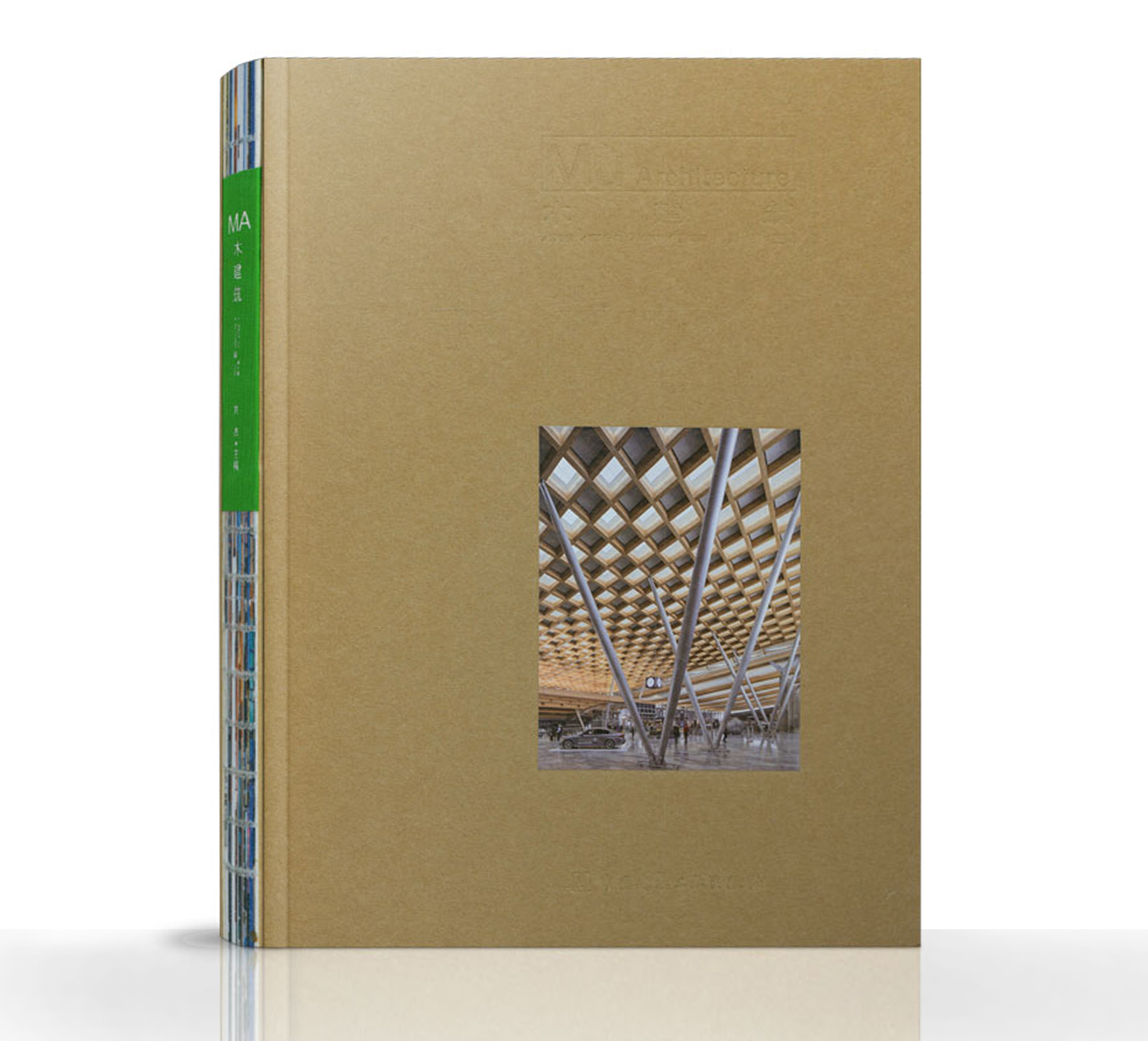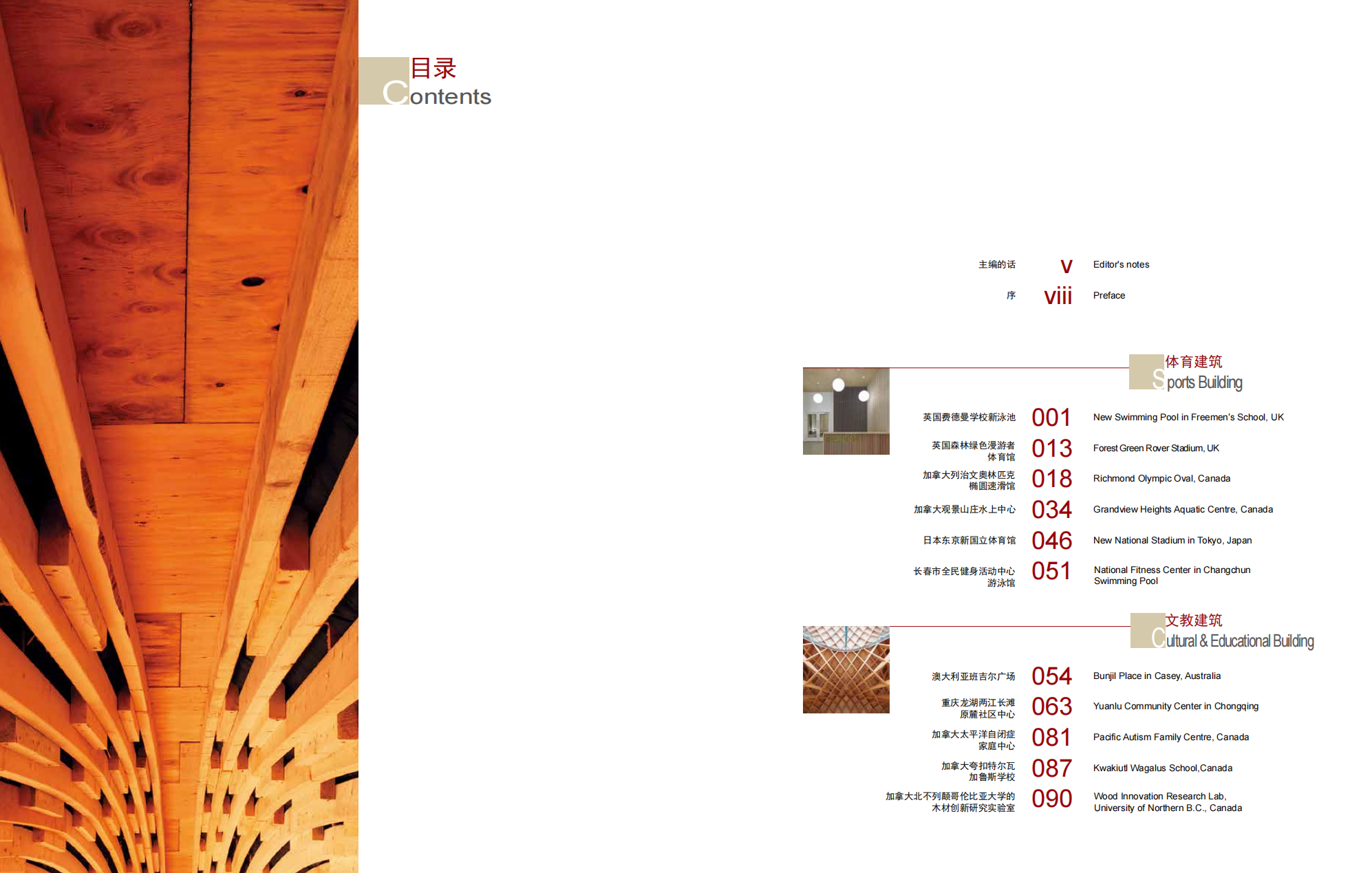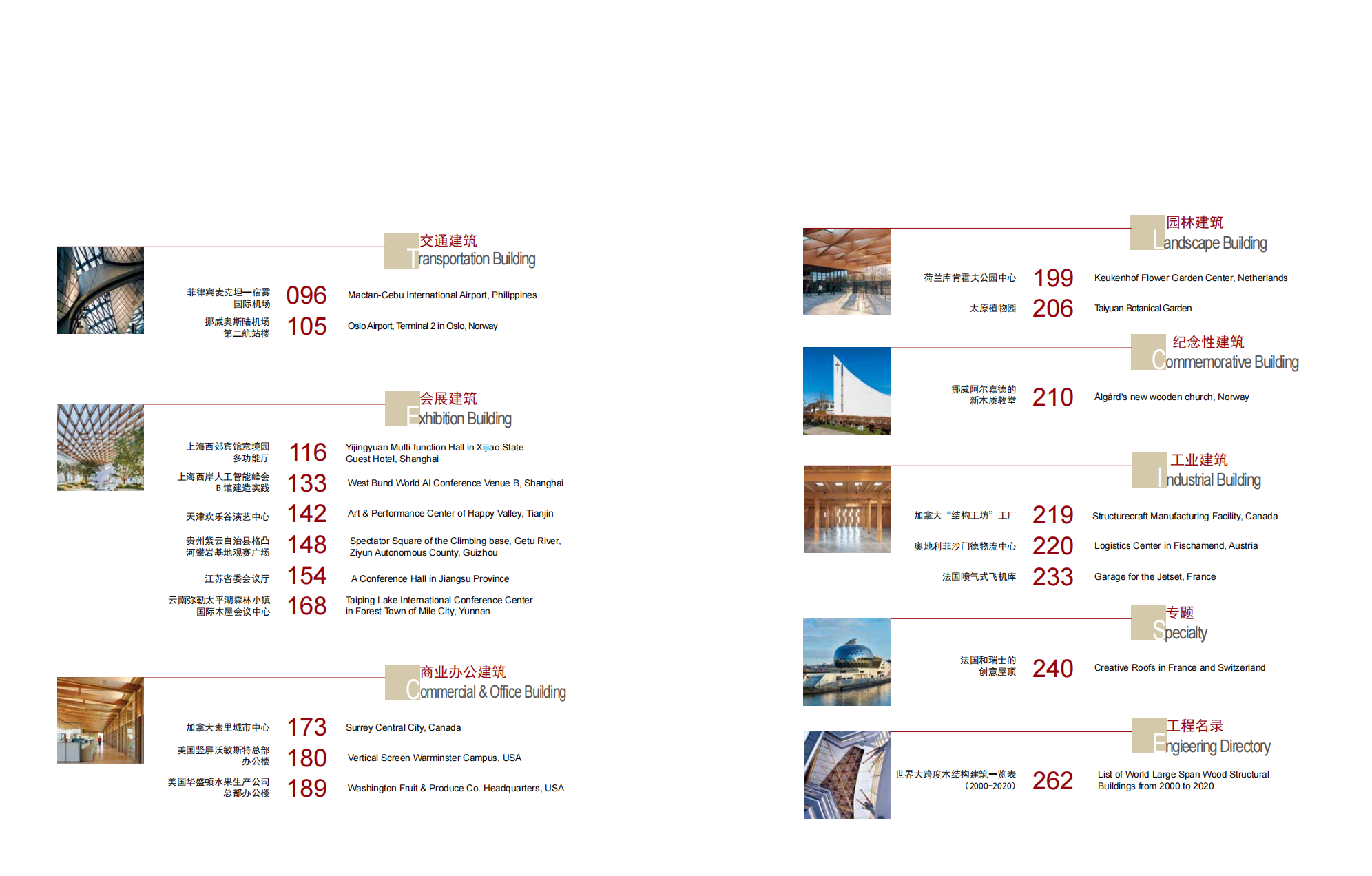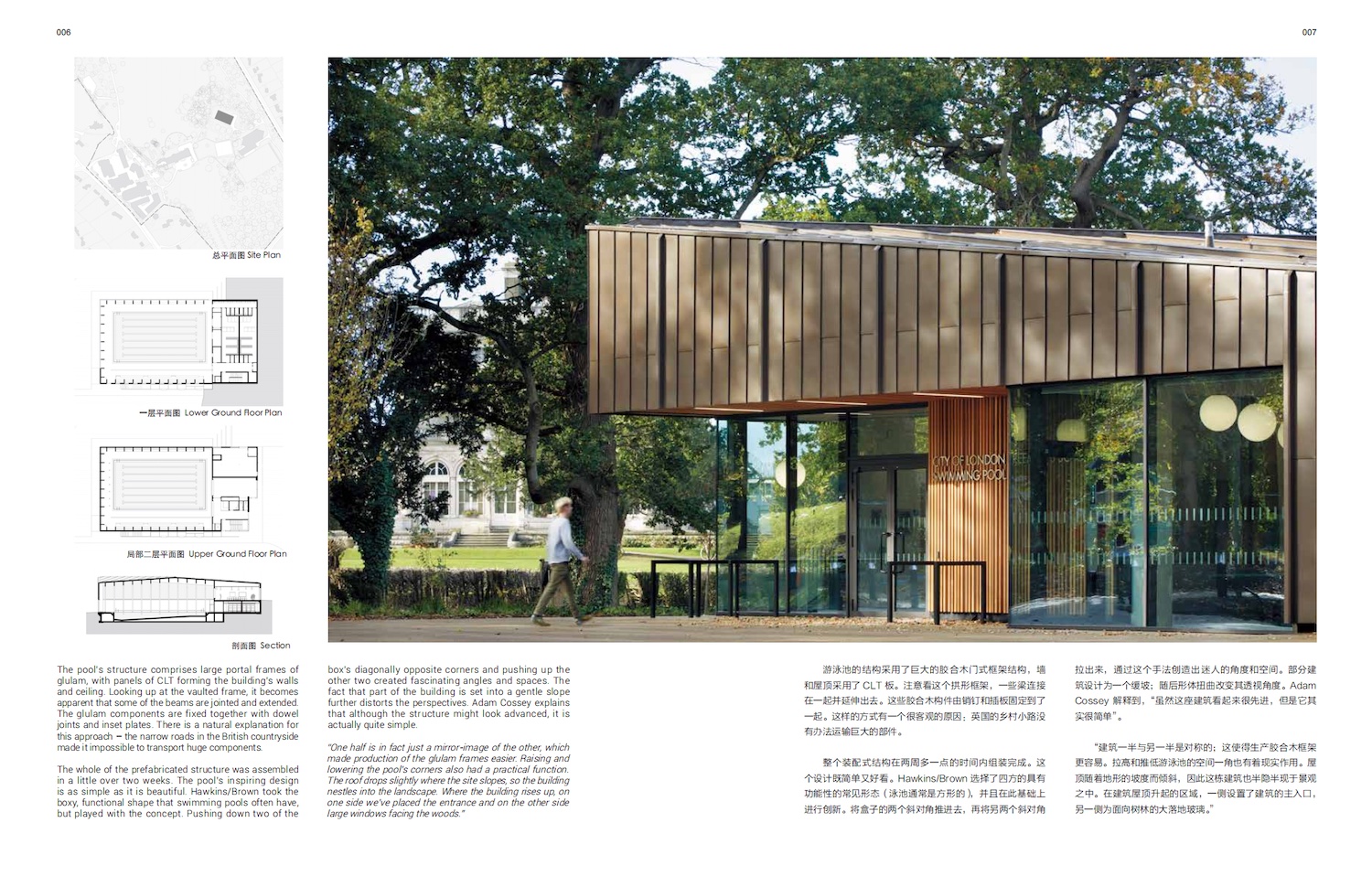
作者:刘杰
出版社:中国建筑工业出版社
ISBN :9787112248926
语言:
中文
《木建筑·第2辑》
继科学出版社于2017年6月出版的《木建筑·第1辑》,《木建筑·第2辑》经过3年酝酿,终于在近日由中国建筑工业出版社出版面世。第2辑主要分享了诸多全球优秀的大跨度木建筑案例,汉英对照,多跨页大图,全彩16开本,并结合木建筑环保主题采用轻型再生环保哑光纸印刷,比第1辑铜版纸阅读体验感更佳。
序
Preface
欣闻上海交通大学设计学院刘杰主编的《木建筑》第 2 辑即将面世,很高兴为此写几句话。
众所周知,中国当前已经进入了一个生态文明建设的新时代,中国政府向世界庄严承诺:中国计 划 2030 年二氧化碳排放达到峰值且将尽早达峰。到 2030 年单位 GDP 二氧化碳排放比 2005 年下降 60%到 65%。但是,目前中国在很多方面还面临比较严峻的挑战。以建筑业材料生产和使用为例,我 国粗钢产量已占全球近一半;二氧化碳排放约 13 亿吨,约占我国总排放 12%。我国水泥产量占全球一 半以上,水泥工业年消耗标煤约 2 亿多吨,占建材行业能源消耗总量的 75%。我国建筑业碳排放所占 比重达到了 50%。由于水泥、钢铁等材料均产自不可再生资源,其生产能耗大、污染比较重。相对来说, 作为一种重要的环保建材,木材的生产和在建筑中的使用还存在很大的发展空间。
从环保角度看,木材属于可再生材料,木结构对环境的污染比钢结构、混凝土结构少很多。木结构 比混凝土结构节能 8%~16%;每立方米木材将储存 0.9 吨当量的二氧化碳,同时在木材生产制造阶段还 可减少 1.1 吨碳排量。党和国家高度重视建筑业木结构的发展。中共中央国务院关于进一步加强城市规 划建设管理工作的若干意见(中发〔2016〕6 号)指出:“发展新型建造方式:积极稳妥推广钢结构建筑。在具备条件的地方,倡导发展现代木结构建筑。”工信部则发文指出:促进城镇木结构建筑应用,推动 木结构建筑在政府投资的学校、幼托、敬老院、园林景观等低层新建公共建筑,以及城镇平改坡中使用。推进多层木—钢、木—混凝土混合结构建筑,在以木结构建筑为特色的地区、旅游度假区重点推广木结 构建筑。在经济发达地区的农村自建住宅、新农村居民点建设中重点推进木结构农房建设。笔者前两年 也在第十届江苏省园艺博览会主展馆建筑中,与葛明教授和徐静高级建筑师等合作,联合南京工业大学 木结构研究所刘伟庆教授和陆卫东教授团队,建筑主体运用了木结构,营造了独特的建筑形象和空间环 境,获得了良好的效果。此外,我们也在南京江宁钱家渡的新农村建设中采用了木结构。
多年来,上海交通大学设计学院刘杰教授团队在传统木结构和现代木结构的结合方面深耕多年, 取得重要的研究和工程实践成果,在业界享有盛誉。本期《木建筑》第 2 辑主题为《大跨度木结构建筑》 专辑,收录了中国、美国、英国、加拿大、法国、挪威、荷兰、奥地利、澳大利亚等多个国家的具有 代表性的大跨度木结构建筑工程。建筑类型涵盖体育建筑、文教建筑、交通建筑、会展建筑、商业办 公建筑、园林建筑、纪念性建筑和工业建筑等。其中包括由扎哈 · 哈迪德建筑事务所设计的英国森林绿 色漫游者体育馆,获得多项国际设计大奖的加拿大列治文椭圆冬奥速滑馆,在业内受到诸多好评的重 庆龙湖两江长滩原麓社区中心等具有设计和技术创新的典型木结构建筑项目。本辑为专业和非专业领 域内的读者深入浅出地介绍大跨度木结构领域的最新技术和应用成果,例如胶合木结构体系和标准化 木构件连接方式等方面,展现大跨度木结构独特的美,同时,分析木材特性如何与功能完美结合的实 际案例和具体做法。期盼为发展中国的大跨度木结构建筑设计和技术领域,提供一定的借鉴。
I am glad that the second series of Mù Architecture edited by LIU Jie from the School of Design of Shanghai Jiao Tong University is about to be released, and I am very happy to write a few words for this.
As we all know, China has entered a new era of construction of ecological civilization, and the Chinese government has solemnly promised the world that China plans to reach a peak of carbon dioxide emissions by 2030 and will reach its peak as soon as possible. By 2030, carbon dioxide emissions per unit of GDP will be 60%~65% lower than in 2005. However, China still faces severe challenges in many aspects. Taking the production and use of construction materials as an example, China's crude steel output accounts for nearly half of the world in total; carbon dioxide emissions are about 1.3 billion tons, accounting for about 12% of the total emissions in China. China's cement output accounts for more than half of the world in total. The cement industry consumes about 200 million tons of standard coal annually, accounting for 75% of the total energy consumption of the construction material industry. Carbon emissions of construction industry in China account for 50% in total. Because cement, steel and other materials are produced from non-renewable resources, their energy consumption for production is large and pollution is relatively heavy. Relatively speaking, as an important environmental friendly building material, there is still great development space for wood in the production and construction.
From the perspective of environmental protection, wood is a renewable material, and the pollution of timber structure to the environment is much less than that of steel and concrete structure. Timber structure is 8%~16% less energy consumption than concrete structure; each cubic meter of wood will store 0.9 tons of equivalent carbon dioxide, and at the same time, it can reduce 1.1 tons of carbon emissions during the its manufacturing stage. The Party and the state attach great importance to the development of timber structure in the construction industry. CPC Central Committee and State Council proposed several opinions on further strengthening the management of urban planning and construction (ZF〔2016〕No. 6) which was pointed out that developing new construction methods and promoting steel structure buildings steadily, and advocating the development of modern timber buildings, where conditions permit. The Ministry of Industry and Information Technology of People's Republic of China pointed out that the application of timber architecture in the urban area is being promoted, and it also promote to adopt timber structure for new low-rise public buildings, such as government-invested schools, nurseries, homes for the elderly, garden landscapes, as well as in the project of urban apartment roof renovation. It mainly promotes to build multi- story timber-steel, timber-concrete hybrid structure buildings, and promotes timber structure buildings in wood-featured areas and tourist resorts. The timber structure is also promoted to apply in rural self-builthouses of economically developed areas and new rural residential areas. In the first two years, the author cooperated with Professor GE Ming and Senior Architect XU Jing to design the project of the main exhibition hall in the 10th Horticultural Exposition of Jiangsu Province. The project is also in conjunction with the team of Professor Liu Weiqing and Professor Lu Weidong from the Institute of Timber Structure of Nanjing Tech University. The main structure of the building is the timber structure, which has created a unique architectural image and environment, and it has achieved good results. In addition, the timber structure is also adopted in the construction of a new countryside in Qianjiadu village of Jiangning, Nanjing.
For many years, the team of Professor LIU Jie from the School of Design of Shanghai Jiao Tong University has been focused on the research of traditional and modern timber architecture for many years, and has got important research and practice achievements, enjoying a high reputation in this field. The theme of this second series of Mù Architecture is the album of the large-span timber architecture. It includes representatively large-span timber construction projects from China, the United States, the United Kingdom, Canada, France, Norway, the Netherlands, Austria, and Australia. The types of buildings cover sports buildings, cultural and educational buildings, transportation buildings, exhibition buildings, commercial office buildings, landscape buildings, monumental buildings, and industrial buildings. It includes many typical cases with design and technological innovation, such as the British Forest Green Rover Stadium designed by Zaha Hadid Architects, the Richmond Olympic Oval in Canada, which has won many international design awards, and Yuanlu Community Center in Chongqing, which has received many praises in the industry. This album provides readers in the professional and non-professional fields with an easy-to-understand introduction to the latest technology and application achievements in the field of large-span timber structure. For example, glulam structural systems and standardized connection methods of timber components. It also shows the unique beauty of large-span timber structure. At the same time, it analyzes practical cases and specific methods of how characteristics of timber material and its construction functions can be perfectly combined. It will be able to a good reference for developing the design and technology of China's large-span wooden buildings.
2019 年 11 月 November 2019
王建国:中国工程院院士,东南大学教授,东南大学城市设计研究中心主任
WANG Jianguo: Academician of Chinese Academy of Engineering (CAE), Professor of Southeast University,
Director of Urban Design Research Center of Southeast University





